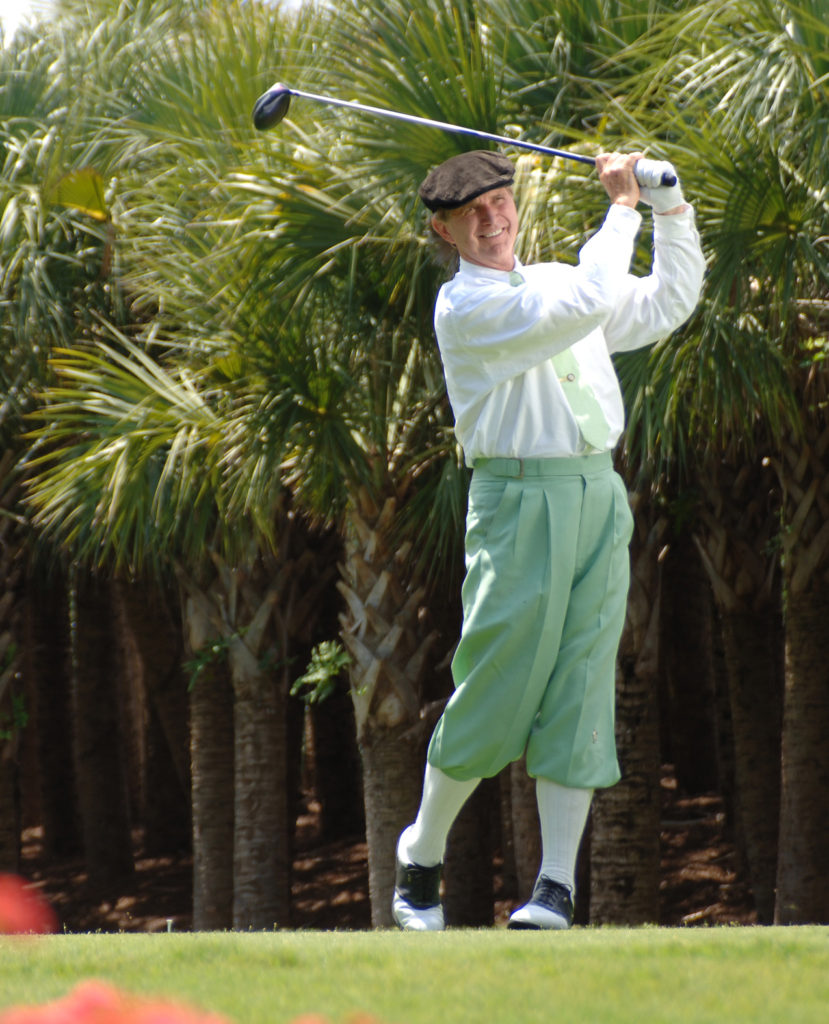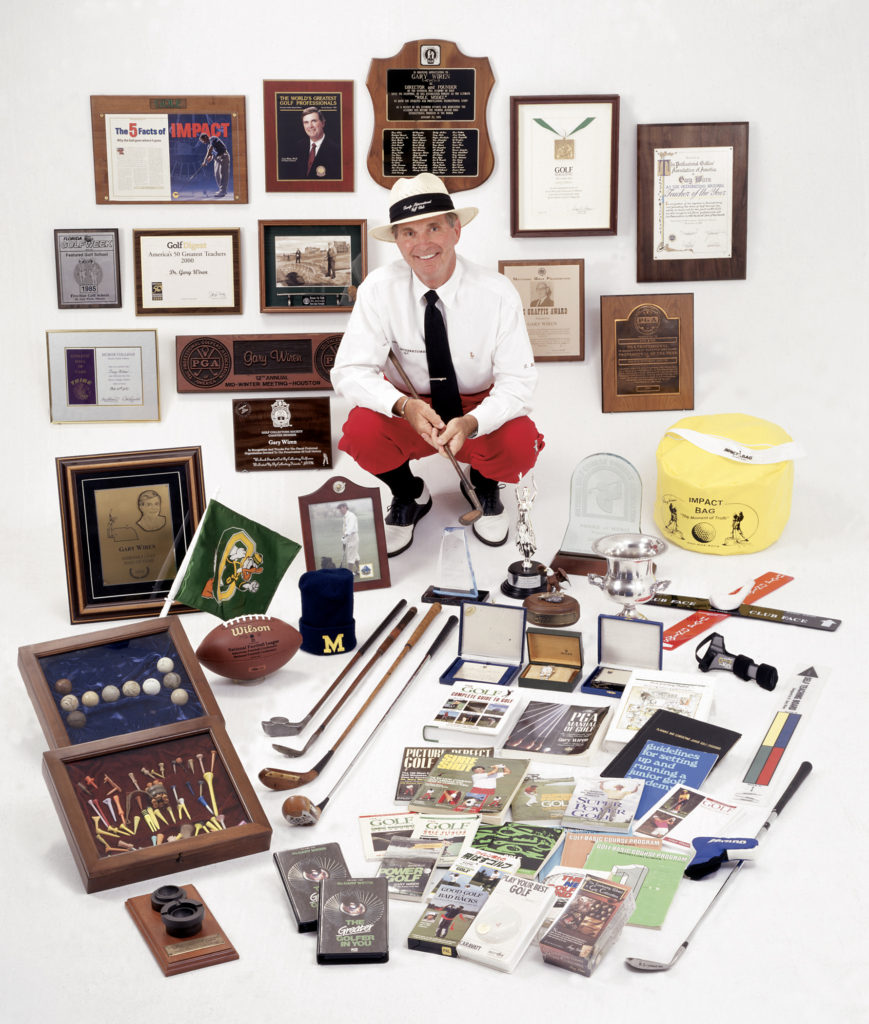Gary Wiren: An amazing golf journey with roots in Eugene
From teaching at Oakway …. to teaching around the world, and Trump International
The final chapters of the amazing golf story of Gary Wiren will be written in Florida, where he has lived and worked for 45 years, and there could be a few chapters, considering that he’s an impressively fit 81 who looks resplendent in plus-fours, prefers to carry his own clubs and can hit a driver in the neighborhood of 300 yards.
But when you’re in multiple golf halls of fame and have earned numerous distinguished service awards; when you have written 14 books and lectured and taught all over the United States and abroad; when you have been a pioneering figure in the fields of golf instruction, rules education and professional golf management; when you have amassed one of the most unusual collections of golf memorabilia in the world and have showed it off to Warren Buffett, a friend, and Bill Gates at the same time; when you are a successful entrepreneur and inventor in the field of golf teaching aids; and when you hold the title of senior director of instruction for the golf courses owned by President Trump …

It’s where the Gary Wiren story starts that we care about today, because it all started here. In Eugene.
Oh, there’s stuff before that. He grew up in Nebraska, played football and took up golf on a nine-hole municipal course with no practice range, no practice green, no bunkers or water hazards and became a collegiate conference golf champion. He was also a Little All-America quarterback for NAIA Huron College in South Dakota, and then a graduate assistant football coach for Bump Elliott while earning his master’s degree at Michigan, and a golf pro before he became director of athletics at Huron at age 24.
But let’s pick up the action in August 1962, when the 26-year-old Wiren drove a Nash Rambler into Eugene with his wife, Ione, and young son Tracy, pulling a U-Haul trailer, to begin working toward a doctorate in sports science at the University of Oregon. Wiren’s plan was to earn his Ph.D in two years and become a university professor. That plan changed direction his first day in Eugene.
The R-G golf school
Wiren was interested. Hope asked Wiren, can you play? Wiren had his clubs in the car, and they played the back-nine of what was then an 18-hole regulation course. Wiren shot a 4-under 33.
“I guess you can play,” Hope said.
In a life-changing decade in Eugene, Wiren never shot that score there again.
“All of the coincidental things that happened, the breaks I got, the right thing happening at the right time …,” Wiren said.
Before his first doctoral class he had a title, teaching pro at Oakway, and a job giving golf lessons. Oakway had a 20-tee covered practice range and Wiren set out to fill those slots by giving group lessons.
He wasn’t bashful. He went to service clubs to drum up business, and in a couple of years reached agreement with The Eugene Register-Guard to hold a golf school that carried the newspaper’s name. The R-G promoted the school with advertising; Wiren managed the program and kept the fees. He estimates that he taught 16,000 lesson hours of instruction in Eugene, developing what would evolve into his teaching philosophy of the “laws, principles and preferences” of golf.
And making some money. By the time he earned his doctorate in 1971, writing his dissertation on “Human Factors Influencing the Golf Drive for Distance,” the Wirens owned a four-bedroom house, a six-unit apartment house, a used Mercedes-Benz and a Volkswagen station wagon. As a graduate student.
“The Eugene Register-Guard was really a catalyst in my life,” Wiren said.
In 1965, Wiren was hired by the UO athletics department as events manager. (He also taught Sunday school for six years, volunteered in the Big Brother/Big Sister program and later taught a fitness class.) He was in his office in McArthur Court when a visitor noted five hickory-shafted clubs the novice collector had on display.
“He said, ‘I know a guy who has a whole basement full of that stuff and he lives just up the street,’” Wiren recalled.
There were 400 clubs from the 1800s and early 1900s, some made by Old Tom Morris and Willie Park Jr., goose-neck putters, sand irons, cleeks, spade mashies and niblicks and more. They had been owned by Chester Horton, a turn-of-the-century golf teacher and golf columnist, and were now in possession of his son. Wiren went to three banks and got a loan, returning with a U-Haul trailer.
Those clubs formed the first major building block of one of the world’s great collections — roughly 2,800 clubs, 2,000 golf balls, 2,000 books, 5,000 postcards and hundreds of other items such as stamps, sheet music, magazines and tees. Wiren is one of the 25 founding members of the Golf Collector’s Society of America, and his collection has been featured on ESPN and the Golf Channel.
The rest of the story (and Trump)
Wiren’s position as the teaching pro at Oakway led to an affiliation with the Pacific Northwest chapter of the PGA of America, which named him regional education director. He developed a five-year educational program for club professionals that impressed Leo Fraser, then the national president of the Florida-based PGA of America, who offered the position of national education director, a job that the now-Dr. Gary Wiren accepted in 1972.
Working for the PGA, Wiren created a national re-certification program for club pros to require awareness of the industry’s best standards. He worked with the U.S. Golf Association to develop the first workshops for rules officials. Among other achievements, in different roles through 1984, he helped establish a university program in golf management and a national camp for juniors golfers.
Wrote golf instructor J.D. Turner, Wiren “was a pioneer in recognizing that a club professional needed to improve as a business person, teacher-coach, junior leader, negotiator and model of the game’s ethics.”
After leaving the PGA, Wiren became an entrepreneur, inventing a training aid, the “Moment of Truth” impact bag, and founding Golf Around the World, now operated by his son, Dane, to sell training aids (www.golftrainingaids.com). It started as a home business with eight products and now lists 150; a Golfweek columnist dubbed him “the godfather of teaching aids.”
And Wiren began a high-profile teaching career — he established the Five-Star Golf School in Boca Raton, Fla., in 1985, he went overseas, to roles in Japan as director of instruction for Mizuno and to Italy as coach for the Italian Golf Federation, and in 1987, by then a PGA Master Professional, he was hired at PGA National in Palm Beach Gardens.
Described as a “philosopher coach,” Wiren was PGA teacher of the year in 1987 and for years a regular on lists of the nation’s top teachers. In 1990 he wrote the 600-page “PGA Teaching Manual: The Art and Science of Golf Instruction,” a three-year project considered to have had international impact on teaching pros.
Over the years, he played some professional tournaments in the U.S. and Japan, including the U.S. Senior Open at Pinehurst in 1994 (carrying his clubs, he shot 75-72 to make the cut), was a hickory golf champion and won a long-drive contest with a mark of 381 yards, 1 foot.
By 2000 Wiren was teaching at Trump International Golf Club in West Palm Beach, Fla. He now holds the title of senior director of instruction for the Trump courses worldwide, sending the latest research to teachers, writing a quarterly newsletter and polishing an image as perhaps the best-dressed teacher in golf, coordinating his colors to honor special guests. Which is possible when you own 22 pairs of plus-fours, 104 ties, 30 hats and caps, 72 pairs of long socks for the plus-fours, 14 pairs of shoes, and many tie tacks and tie bars.
And, yes, he’s seen the now-President play.
His scouting report: “He’s a good player. … He’s got adequate distance, is a very good bunker player and he’s an excellent putter with not what you would call a good-looking putting stroke. But he thinks he’s the world’s great putter and so he makes a lot of putts.”
According to one estimate, Wiren’s taught more than 250,000 people in 34 countries. His thick scrapbooks contain notes and letters from Byron Nelson, Jack Nicklaus and Arnold Palmer, and luminaries in the world of sports, business and broadcasting. In 2006 he was the 15th inductee into the World Golf Teachers Hall of Fame and was named to the PGA Golf Professional Hall of Fame.
Wiren and Ione, married 56 years, live in North Palm Beach. Now and then, someone asks “Dr. Golf” when he’ll retire.
“What would I do?” he mused. “Go play golf? I already do that. I get paid for it.”
He has unfinished projects, including expanding the professional golf management curriculum to include the nine core values of the juniors First Tee program — such as integrity, perseverance and sportsmanship — the values of sport an important concept for Wiren since his days as a UO doctoral student. Which is where this all began in August 1962.
“We didn’t know anybody in Eugene,” Wiren said, looking back. “How these things happened … There’s something up there in the universe that causes these things to happen like this.”
(Originally appeared in the Eugene Register-Guard on June 20, 2017.)

